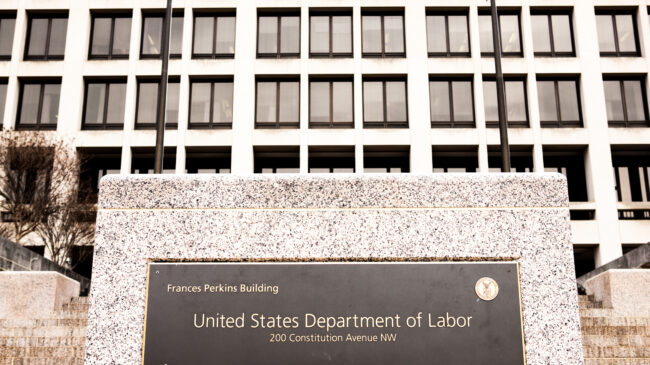The U.S. Department of Labor released a final rule last month that could have a major impact on how retirement plan fiduciaries interact with environmental, social, and governance (ESG) factors. The Labor Department’s new action takes a clear side in the ongoing debate about political activism in retirement funds, explicitly allowing ESG to be included in what is considered within a fiduciary’s scope of responsibility under the Employee Retirement Income Security Act (ERISA).
According to Department of Labor (DOL) statements, the rule “removed barriers to considering [ESG] factors in plan investments” and will provide more flexibility in “exercising shareholder rights.”
But those critical of using ESG factors to make public pension systems’ investment decisions believe this move exposes retiree savings to oftentimes unexpected or counterproductive social and political agendas when risks and returns should be the sole investment factors. This new rule sets the stage for state governments to establish their own standards, which could prompt state legislatures to set up guardrails against political investing.
Institutional investors, corporations, credit rating agencies, and governments are increasingly adopting an ESG framework into their investment decision-making. The idea behind ESG is to create a more accurate accounting of the negative externalities—be they environmental or social caused by industries, businesses, and individuals and to use this knowledge to positively influence the future. This ESG framework is implemented in a variety of ways.
ESG investment policies typically seek to avoid assets that are deemed to be harmful to the environment. Some institutional investors adopt and promote ESG principles in hopes of influencing the companies they invest in. ESG ratings are applied to companies to measure—albeit arbitrarily—the negative impact they may impose on various environmental and social areas. All of this is increasingly present in both the public and private sectors.
Traditionally, those who are tasked with managing collective retirement funds, including either a 401(k) plan or a pension plan, have what is called a fiduciary responsibility to the members of those plans. Fiduciary responsibility is the focused objective of managing and growing investment funds at acceptable levels of risk. Any other interest or objective is supposed to fall outside of the fiduciary’s purview, making it out of bounds for any consideration in investment decisions.
For privately-run retirement plans, these standards are set by the Department of Labor through ERISA. In the waning months of the Trump administration, the Labor Department issued a rule that reinforced the traditional understanding of what a plan sponsor can consider when making investment choices for its members, specifying that making choices based on ESG factors would be out of bounds. The department also released a proposal that would significantly restrict retirement plan administrators from directly influencing equities through stockholder voting—a process called proxy voting—on ESG-related issues.
In response to these protections from 2020, the Biden administration’s DOL has reversed course. Through the implementation of this latest rule, specific restrictions on making ESG considerations a part of investment decisions have been removed, allowing 401(k) plans under ERISA to insert ESG metrics into their risk and return evaluations. The rule also reverses the restrictions on proxy voting that were applied in 2020, opening up possibilities for retirement plans to use stakeholder positions to shape the decisions of the companies they are investing in, even if the matter is unrelated to economic outcomes.
According to a statement on by United States Secretary of Labor Marty Walsh, the rule will “end the chilling effect created by the prior administration on considering environmental, social, and governance factors in investments.”
Walsh added, “Today’s rulemaking is an important step toward a more secure financial future for America’s workers and their families.”
However, his position remains politically polarizing, most evident in the response from Republican senators who have submitted a resolution to reverse the rule.
What will these latest developments mean for employees and retirees who are counting on their pension plans to act on their behalf as fiduciaries? It indicates that the federal government is not going to get in the way of retirement plan managers who choose to insert political, inconsistent, and often controversial ESG factors into their decision-making. Those looking for protection from politically motivated shirking of fiduciary responsibility will have to turn to state governments.
With a lot still to be determined in the world of retirement plans and fiduciary responsibility, the full impact of the DOL’s latest rule remains unclear. At the very least, it sets the stage for more debate on the matter, which will ultimately take place at the state level. State policymakers have already begun to set strong definitions of what a fiduciary can consider in making investment decisions.
For public pension funds, which are not bound by ERISA and therefore largely unaffected by the Labor Department’s recent rule, state policymakers should consider legislation to keep activist campaigns away from taxpayers’ money in keeping apolitical funds from politicization. Setting clear boundaries for what a public pension can consider when making investment decisions—the approach taken by Florida’s State Board of Administration and proposed in a piece of legislation in Michigan—is the optimal way to protect these funds from activism from any political side.
Stay in Touch with Our Pension Experts
Reason Foundation’s Pension Integrity Project has helped policymakers in states like Arizona, Colorado, Michigan, and Montana implement substantive pension reforms. Our monthly newsletter highlights the latest actuarial analysis and policy insights from our team.

